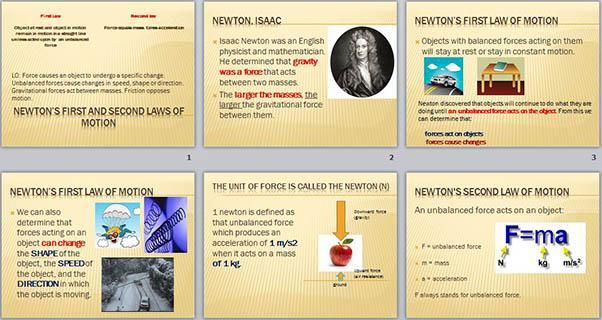
First Law
Object at rest and object in motion remain in motion in a straight line unless acted upon by an unbalanced force
Second law
Force equals mass times acceleration
LO: Force causes an object to undergo a specific change. Unbalanced forces cause changes in speed, shape or direction. Gravitational forces act between masses. Friction opposes motion.
Newton’s first and second laws of motion

Newton, Isaac
- Isaac Newton was an English physicist and mathematician. He determined that gravity was a force that acts between two masses.
- The larger the masses , the larger the gravitational force between them.

Newton’s First Law of Motion
- Objects with balanced forces acting on them will stay at rest or stay in constant motion.
Newton discovered that objects will continue to do what they are doing until an unbalanced force acts on the object . From this we can determine that:
forces act on objects
forces cause changes

Newton’s First Law of Motion
- We can also determine that forces acting on an object can change the SHAPE of the object, the SPEED of the object, and the DIRECTION in which the object is moving.

The unit of force is called the newton (N)
1 newton is defined as that unbalanced force which produces an acceleration of 1 m/s2 when it acts on a mass of 1 kg.
Downward force
(gravity)
Upward force
(air resistance)
ground

Newton's Second Law of Motion
An unbalanced force acts on an object:
F always stands for unbalanced force.

Acceleration
The direction of the object's acceleration is the same as the direction of the unbalanced force

Friction
- When two surfaces slide past each other, the interaction between them produces a force of friction. Friction is a force that opposes motion.

In this diagram, the book is moving to the right across the table as shown by the red arrow.
A book lying on a table with an arrows pointing left and right to show the friction on the book and on the table, plus an arrow pointing right showing movement of the book.

Weight (Newtons,N)
- In physics, the term weight has a specific meaning - which is the force that acts on a mass due to gravity.
- Weight is measured in Newtons.
- Mass is measured in kilograms.

Weight is not the same as mass
- Mass is a measure of how much stuff is in an object.
- Mass is measured in kilograms, kg
- Weight is a force acting on that stuff
- Weight is the result of gravity. The Earth's gravity attracts objects towards the centre of the Earth and you feel forces like this as weight.
- Weight is measured in newtons, N

Weight is the result of gravity
- The gravitational field strength of Earth is 10 N/kg (ten newtons per kilogram).
- This means an object with a mass of 1 kg would be attracted towards the centre of Earth by a force of 10 N.
- We feel forces like this as weight.

Weight
On Earth , if you drop an object it accelerates towards the centre of the planet. The weight of an object is calculated using this equation:
- weight (N) = mass (kg) × gravitational field strength (N/kg)

gravitational field strength is:
- 10 N/kg on Earth
- 1.6 N/kg on the Moon
You would weigh less on the Moon because the gravitational field strength of the Moon is about one-sixth of that of the Earth. But note that your mass would stay the same. For example, what is the weight of an 80 kg person on Earth and on the Moon?
- On Earth, weight = 80 × 10 = 800 N
- On the Moon, weight = 80 × 1.6 = 128 N

On the Moon
- You would weigh less on the Moon because the gravitational field strength of the Moon is one-sixth of that of Earth (1.6 N/kg). But note that your mass would stay the same.

Key words
Acceleration - the rate of change in speed (or velocity), measured in metres per second squared.
Acceleration = change of velocity ÷ time taken
m/s2
Gravity - the force of attraction between all objects. The more mass an object has, the larger the force of gravity it exerts. N/kg
Velocity - the speed of an object in a particular direction.

Resultant forces
- An object may have several different forces acting on it, which can have different strengths and directions. But they can be added together to give the resultant force .
- When all the forces are balanced , the resultant force is zero . In this case:
- a stationary object remains stationary
- a moving object keeps on moving at the same speed in the same direction

Resultant forces
- When all the forces are not balanced, the resultant force is not zero. In this case:
- A stationary object begins to move in the direction of the resultant force.
- A moving object speeds up, slows down or changes direction depending on the direction of the resultant force.

Newton’s Second Law of Motion
- An unbalanced force acts on an object:
- the direction of the object's acceleration is the same as the direction of the unbalanced force
- the magnitude of the object's acceleration varies in direct proportion with the size of the unbalanced force
- the magnitude of the object's acceleration varies inversely with the mass of the object


 Получите свидетельство
Получите свидетельство Вход
Вход































 Презентация к уроку физики по теме "Законы Ньютона" (на английском языке) (2.81 MB)
Презентация к уроку физики по теме "Законы Ньютона" (на английском языке) (2.81 MB)
 0
0 2488
2488 326
326 Нравится
1
Нравится
1


